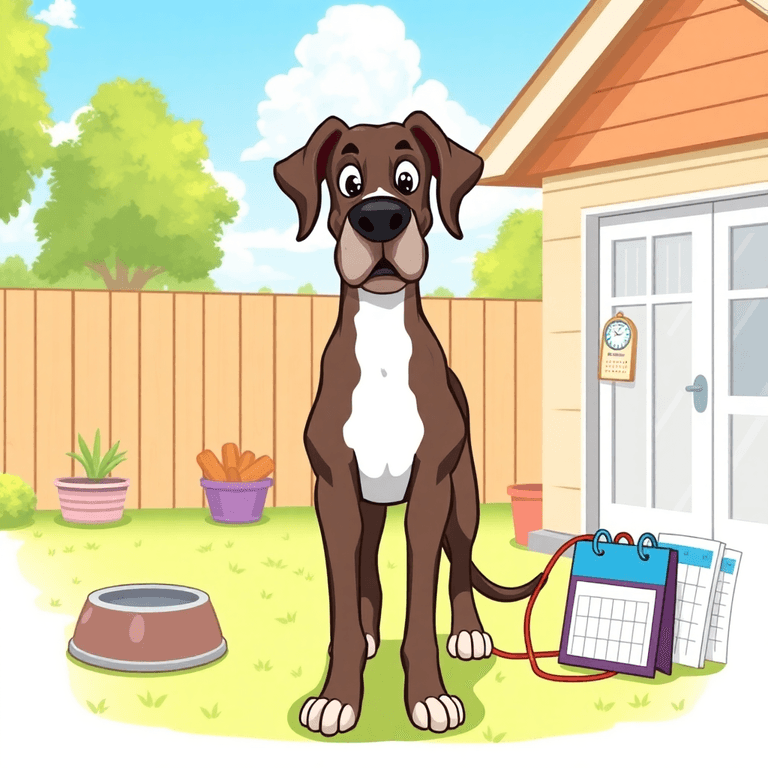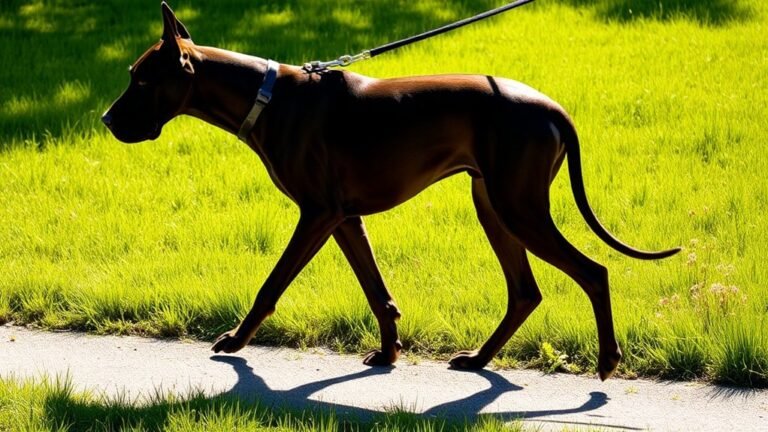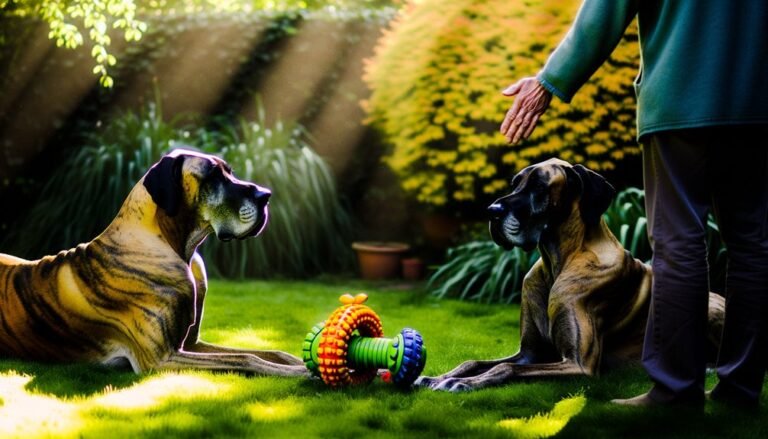Drool and Daydreams: Multitasking Expert at Rest.

Daily Routine for a Great Dane
To create a happy, healthy life for us Great Danes, our humans start with a consistent morning routine and a nutritious breakfast. Trust me, I know exactly when breakfast time is – my internal clock is more accurate than any alarm! My humans guarantee midday activities include mental stimulation and play, which is great because I get bored easily and might decide to redecorate the living room with couch stuffing.
They follow this with evening walks to help me expend energy, though let’s be honest – after about ten minutes, I’m ready to flop down dramatically like the world’s largest drama queen. Regular grooming keeps my coat healthy, even though I prefer rolling in mud puddles. Dental care is essential for my teeth, but I still don’t understand why I can’t just chew on the neighbor’s garden hose instead.
While the day winds down, we enjoy quiet moments together, which usually means me taking up 90% of the couch while my humans squeeze into whatever space is left. If you want to learn more about perfecting this routine, we’ve got plenty of insights to share – mostly involving treats and belly rubs!
Morning Routine and Breakfast
Woof! Let me tell you about my favorite time of day – breakfast time! When I wake up each morning, my humans better have their act together because this gentle giant needs to start the day right.
First things first – I’ve got my humans trained on a pretty solid feeding schedule. They’ve learned that when my internal clock says “FOOD TIME,” there’s no arguing with 120 pounds of hungry Great Dane. Keeping things consistent helps my tummy work properly, and trust me, nobody wants an upset Great Dane stomach!
My breakfast is like a gourmet meal fit for a king (which I am). My humans make sure I get all the good stuff – proteins to keep these massive muscles strong, fats for my shiny coat, and carbs for energy to chase squirrels later. They stick to formulas with controlled protein levels to support my healthy growth.
My breakfast is a royal feast loaded with proteins, fats, and carbs—everything a majestic Great Dane needs to conquer the day!
They’re pretty smart about measuring my portions, too, because apparently “eating until the bowl disappears” isn’t the right amount.
The best part? My humans give me the fancy, high-quality kibble. None of that bargain-bin stuff for this magnificent beast! They watch me eat like I’m performing Shakespeare, making sure I’m growing properly and have enough energy to knock things over with my enthusiastic tail wags.
This whole morning routine isn’t just about filling my enormous belly – it’s quality bonding time with my favorite humans. Though let’s be honest, they’re mostly just my personal breakfast servants, and I love them for it!
Midday Activities and Exercise
When the sun is high and my breakfast has settled, that’s when this big boy needs to MOVE!
Training games are the best! Not only do I get to show off how smart I am (and I’m pretty brilliant, if I do say so myself), but I also get to spend quality time with my favorite humans. Plus, treats are usually involved, which is always a win in my book!
Playtime with other dogs is awesome too, as long as my humans keep an eye on things. Sometimes the little dogs forget I’m not actually a pony and try to climb on me. It’s pretty funny, but supervision helps everyone stay safe while I burn off my energy and practice my social skills.
Whether we’re playing fetch (I may be big, but I can move fast!) or trying out some agility courses, these activities make me feel amazing. It’s important to remember that regular fitness can mitigate the impact of age-related conditions, keeping me healthy and happy.
Just remember – I need lots of room to run around. My tail alone could knock over a small child, so let’s make sure we’ve plenty of space for all this midday fun!
Evening Walks and Playtime
When the sun starts going down, us Great Danes get super excited for our evening walks and playtime! This is the best part of winding down after a crazy day of being awesome.
Evening games are seriously the best – whether we’re playing fetch (and maybe accidentally knocking over a lawn chair with our enthusiastic retrieval skills) or having an epic tug-of-war battle where we pretend you’re actually strong enough to win. These games help us burn off any leftover energy from the day and remind you why you’re our favorite human.
During our walks, we practice “leash training,” which means we try really hard not to drag you toward every interesting smell we encounter. And trust me, there are A LOT of interesting smells out there!
We’re working on being well-behaved and paying attention to you instead of that fascinating fire hydrant three blocks away.
Walk time is like our personal exploration adventure. We get to sniff everything (and I mean EVERYTHING), check out what the neighborhood dogs have been up to, and enjoy the fresh air while you get some exercise too.
You’re welcome for keeping you in shape!
Here’s the thing – a chill evening really helps us settle down for a good night’s sleep. Without proper playtime and walks, we might decide your favorite shoes look like excellent chew toys at 2 AM. Engaging in structured mental activities during our playtime keeps us mentally sharp and prevents us from getting bored.
These evening moments together aren’t just fun – they’re super important for keeping us happy, healthy, and out of trouble!
Grooming and Dental Care
Grooming and Dental Care
Hey there, humans! Let me tell you about keeping us Great Danes looking fabulous – and trust me, we know when we look good!
You’ll want to get some really good brushes, like slicker brushes and those fancy de-shedding tools. Even though our coat is short, we still shed like crazy (sorry about your black clothes!).
Brushing us regularly feels amazing and keeps our skin super healthy. Plus, it means less of our fur floating around your house – you’re welcome! Regular grooming also helps distribute natural oils, which are essential for maintaining a shiny coat.
Now, let’s talk about something less fun but totally important: brushing our teeth. I know, I know, it sounds weird, but we need you to brush our chompers several times a week with that dog toothpaste stuff. Please don’t use your minty human toothpaste – yuck!
Here’s the good news: dental chews are basically treats that clean our teeth. It’s like getting dessert while doing chores!
When you keep up with all this grooming and teeth cleaning, we stay healthy, happy, and ridiculously handsome. And let’s be honest – we Great Danes are already pretty gorgeous to begin with!
Nighttime Wind Down and Relaxation
When the day winds down, we Great Danes really know how to chill out! Trust me, after a long day of being magnificent and towering over everyone, we need our beauty sleep. Creating a peaceful vibe is super important for us big pups. Here’s how we like to wind down (and you should totally join us):
| Activity | Purpose | Timing |
|---|---|---|
| Quiet Walk | Get those last wiggles out | 30 minutes |
| Gentle Massage | Work out the kinks from being huge | 15 minutes |
| Soft Music | Set the mood for snooze time | 10 minutes |
| Cozy Bedtime Snuggle | Show you’re our favorite human | Until we’re snoring |
Look, being a Great Dane isn’t easy work. We spend all day accidentally knocking things over with our tails, trying to fit on furniture that’s way too small for us, and pretending we don’t see you when you call us “lap dogs.” By evening, we’re ready to turn into gentle giants who just want to relax.
The quiet walk helps us burn off any leftover energy from the day. Plus, it gives us one last chance to investigate all those fascinating smells in the neighborhood. The massage is amazing because, let’s face it, carrying around all this magnificence can make our muscles sore. And don’t even get me started on how much we love those bedtime snuggles – even if we do take up most of the bed! After all, getting adequate rest is vital for our health and well-being.
Final Thoughts
Woof! Who knew being a Great Dane required so much scheduling? I mean, I’m basically running a tight ship over here with my humans. First, there’s breakfast time – and trust me, I’ve trained my family well to serve it at exactly 7 AM. No snooze button allowed when you’re dealing with 150 pounds of hungry dog!
Then comes playtime, which is really just me teaching my humans how to throw a ball properly. It only took them six months to get it right. After that, there’s the dreaded grooming session where my humans pretend they’re in charge while I graciously allow them to brush my magnificent coat.
By bedtime, I generously let my humans share about 10% of “their” bed while I sprawl across the rest. Sure, they grumble about my size, but I know they love having their very own living, breathing teddy bear. Between you and me, I think I’ve got this whole family thing figured out. A little routine, some strategic cute looks, and boom – I’m living the dream!
References
- https://www.cornucopiapetfoods.com/blogs/news/the-great-dane-care-guide
- https://www.petmd.com/dog/breeds/great-dane
- https://www.pdsa.org.uk/pet-help-and-advice/looking-after-your-pet/puppies-dogs/large-dogs/great-dane
- https://www.thefarmersdog.com/digest/the-great-dane-guide-history-personality-food-training-care-and-more/
- https://www.youtube.com/watch?v=k2fluzIW1Dg







4 Comments